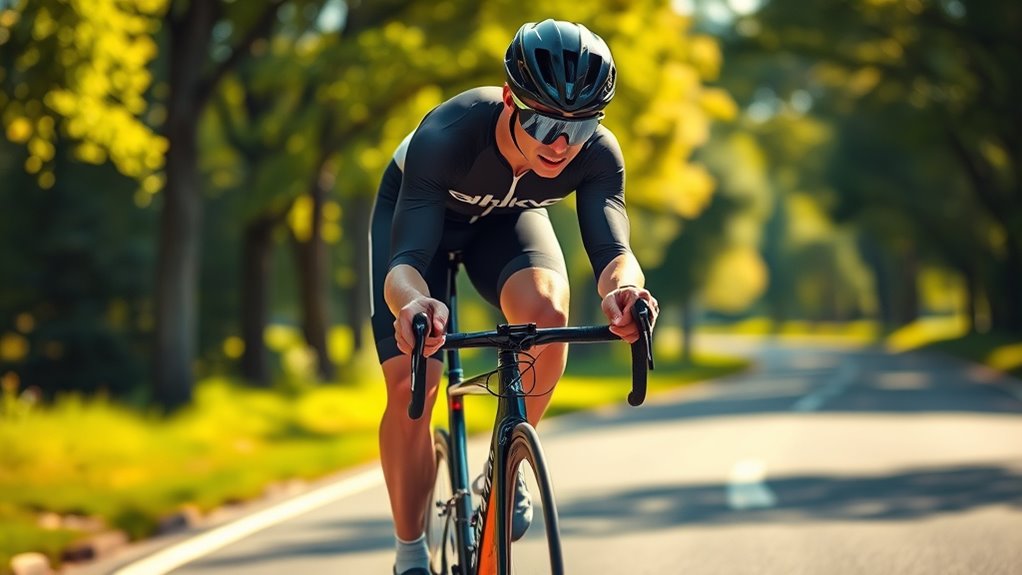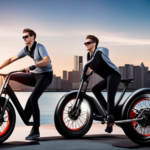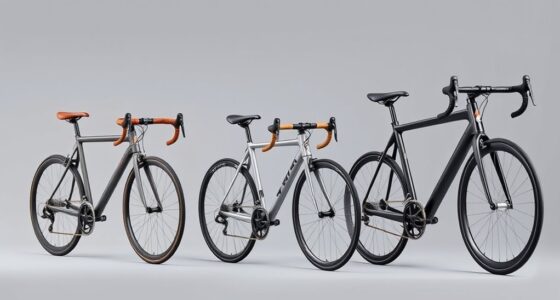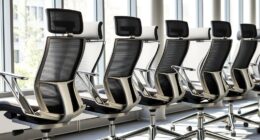Use aerobars mainly on flat terrain, into headwinds, or during time trials to boost your aerodynamics and speed. Switch to this position when you want to reduce wind resistance and gain extra efficiency, especially in races or fast rides. Avoid using them on steep climbs or technical descents where control matters most. Proper positioning enhances safety and performance. Keep exploring to learn how to set up and use your aerobars effectively.
Key Takeaways
- Use aerobars during flat terrain or headwinds to maximize aerodynamic advantage and increase speed.
- Switch to aerobars in time trials, triathlons, or races emphasizing aerodynamics.
- Avoid aerobars when climbing hills, descending technical sections, or during technical maneuvers requiring control.
- Incorporate aerobars gradually into training to build endurance and comfort before races.
- Revert to standard handlebars during climbs, descents, or when maintaining stability and control is critical.
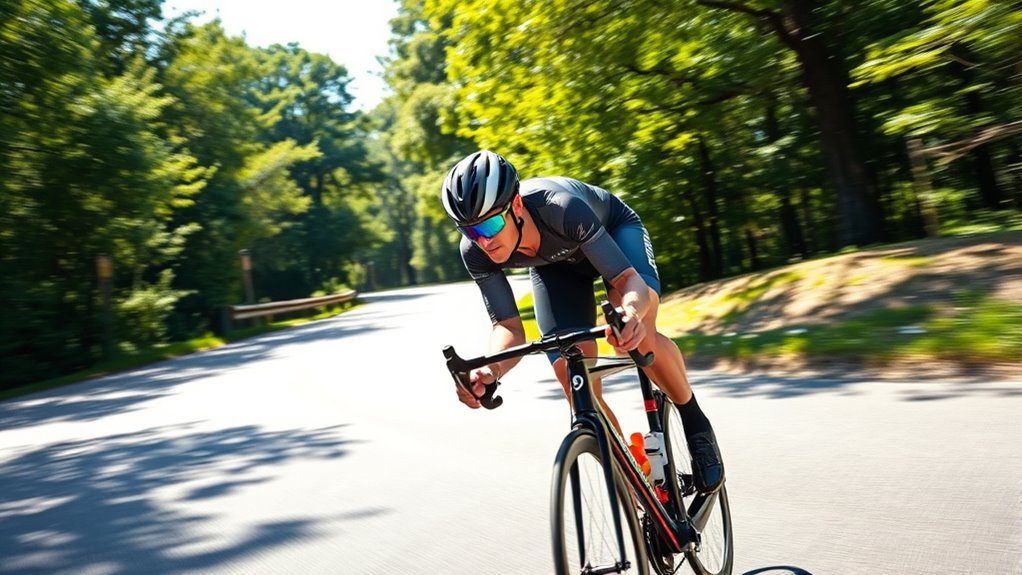
Aerobars are a valuable addition to your bike setup, but knowing when to use them can make a significant difference in your performance. Proper aerobar positioning is key to maximizing their benefits, so you’ll want to adjust them carefully to suit your body and riding style. When you set up your aerobar accessories, ensure that they’re aligned to keep your forearms comfortable and your shoulders relaxed. This positioning helps reduce wind resistance and allows you to maintain a more aerodynamic posture for longer periods. If your aerobar accessories are adjustable, take the time to experiment with different angles and extensions until you find a position that minimizes strain and feels natural.
Proper aerobar setup ensures comfort, reduces wind resistance, and maintains an aerodynamic posture for longer rides.
Once you have your aerobar positioning dialed in, you can start considering when to use them during different riding scenarios. Aerobars are most effective during time trials, triathlons, or any race where every second counts and aerodynamics play a crucial role. When you’re riding on flat terrain or heading into a headwind, shifting to the aero position can significantly boost your speed by reducing drag. You’ll want to lean forward, resting your forearms on the pads and gripping the extensions lightly, but avoid overextending yourself or locking your elbows. This posture keeps you aerodynamic without sacrificing control or comfort. Additionally, support hours for cycling accessories are available from various retailers if you need to upgrade or adjust your setup.
However, it’s important to recognize that aerobars aren’t ideal for every situation. When climbing hills or navigating technical descents, you should revert to a more upright, relaxed position. Using aerobars in these moments can compromise your stability and control, especially if you’re fatigued or unfamiliar with the setup. Additionally, if your aerobar accessories aren’t securely mounted or if you feel discomfort in your wrists, shoulders, or neck, it’s best to switch back to the standard handlebars. Proper aerobar positioning isn’t just about speed; it’s also about safety and comfort, so listen to your body and make adjustments as needed.
In training, incorporating periods of time in the aero position can build your endurance and comfort with aerobar use. This way, you won’t feel unfamiliar or strained when it counts during a race. Remember, the key to effective aerobar use is finding a balance between aerodynamics and comfort. Use aerobar accessories that suit your body size and riding style, and don’t hesitate to tweak your setup as you gain experience. Knowing when to switch between your aero bars and traditional handlebars can give you a strategic edge, helping you optimize your speed without compromising control or safety.
Frequently Asked Questions
Can Aerobars Be Used on Mountain Bikes?
You generally can’t use aerobars on mountain bikes during trail riding because they’re designed for aerodynamic efficiency on smooth roads, not rugged terrain. Aerobars help you conserve energy on long-distance riding, but they limit your control on technical mountain biking trails. If you’re considering them, be aware that they can influence maneuverability and safety. For mountain biking, sticking to traditional handlebars ensures better handling and safety on challenging trails.
Are Aerobars Suitable for Short-Distance Riding?
Yes, aerobars can be suitable for short-distance riding, especially if you’re looking to improve rider comfort and gain aerodynamics benefits. They allow you to adopt a more aerodynamic position, reducing wind resistance and making your ride more efficient. However, keep in mind that aerobars may take some time to get used to and might not be ideal for all short rides, especially if you prefer a more upright, relaxed posture.
How Do Aerobars Affect Bike Handling?
Using aerobars is like steering a boat; hand positioning shifts your control and feel. They improve your aerodynamics impact by allowing a more streamlined posture, but can make bike handling feel less responsive, especially at slow speeds or tight turns. You might notice it’s harder to quickly react to obstacles. For steady, straight-line riding, aerobars enhance efficiency, but for technical sections, you should be cautious as handling feels different.
What Is the Best Material for Aerobars?
You should choose aerobars made from lightweight, durable materials like carbon fiber or aluminum. Carbon fiber offers excellent aerobar comfort and is highly durable, reducing vibrations and improving ride quality. Aluminum aerobars are more affordable, sturdy, and still provide good comfort, making them a practical choice. Opt for a material that balances aerobar comfort with material durability, ensuring your aerobars last through long rides and tough conditions.
Do Aerobars Improve Cycling Speed Significantly?
Aerobars can markedly improve your cycling speed by enhancing aerodynamics and boosting cycling efficiency. When you adopt an aerodynamic position, you reduce wind resistance, allowing you to pedal faster with less effort. This gain is especially noticeable during time trials or long-distance rides. However, your overall speed increase depends on proper use and fit. If you’re comfortable and maintain good form, aerobars can make a meaningful difference in your performance.
Conclusion
Using aerobars can boost your cycling efficiency and speed, especially on flat or time-trial courses. But don’t rely on them all the time; they’re best for specific situations where aerodynamics matter most. Research shows that adopting the right gear at the right time can markedly improve your performance. So, when you’re aiming to shave seconds off your race or ride longer distances comfortably, consider using aerobars—just remember, they’re a tool, not a constant crutch.
